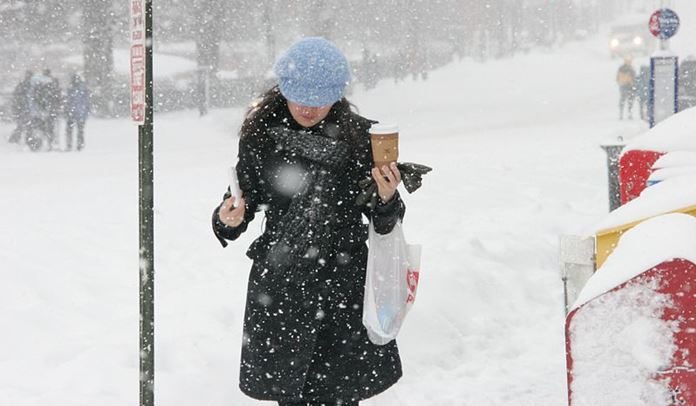Feb. 20 (UPI) — Global warming will bring milder winter weather to much of the Northern Hemisphere, including Europe and North America. But some climate scientists predict those balmy winter days will be more frequently interrupted by extreme cold.
In other words, winters in the future will be — rather counter-intuitively — both warmer and colder.
Earth’s temperature is rising as a result of global warming, but growing carbon emissions are also disrupting the planet’s climate in other subtler and more complex ways. And the effects of global warming — big and small, obvious and indirect — are most pronounced in the Arctic.
In January and February, a slow-moving jet stream allowed a portion of the Arctic polar vortex to spread southward across the Midwest and Eastern Canada. The extreme cold killed 22 people. More recently, a separate polar vortex disruption triggered heavy snowfalls across the Pacific Northwest and Western Canada.
Researchers like Jennifer Francis, a senior scientist with the Woods Hole Research Center, says the diminished difference in temperature between the Arctic and the mid-latitudes is slowing the jet stream. When the jet stream slackens, it becomes wavier and more likely to host big, slow-moving waves.
“The large north-south undulations cause weather regimes to become more persistent,” Francis told UPI. “Big waves move eastward more slowly than small ones. The large waves also tend to extend farther southward, which allows Arctic air to penetrate farther south than usual.”
Francis first published research on the link between climate change and a slackened jet stream in 2012. She has since published two more papers that she says strengthen the hypothesis.
Some scientists agree that a warming Arctic will increase the odds of Arctic air spilling southward into the Midwest and Northeast — but for different reasons than those offered by Francis.
“I have proposed an alternate theory with different iterations of Arctic sea ice loss and increasing Siberian snow cover leading to more frequent disruptions of the stratospheric polar vortex,” said Judah Cohen, climate scientist at Atmospheric and Environmental Research, a weather risk assessment group.
According to Cohen, shrinking Arctic sea ice in the Barents-Kara Seas coupled with increasing Siberian snow has created a combination of warming and cooling that amplifies a tropospheric wave fueled by land-ocean temperature differences.
As the tropospheric wave is amplified, Cohen says more energy is transferred from the troposphere into the polar stratosphere, producing more stratospheric polar vortex disruptions.
Francis and Cohen have support in the scientific community.
“Low sea-ice concentrations in autumn in Barents-Kara Seas favor waves in the atmosphere that propagate upward into the stratosphere and disturb the stratospheric polar vortex in winter,” said Dim Coumou, climate scientist at the Potsdam Institute for Climate Impact Research. “There is now strong evidence, coming from observational studies and climate models, that such a link exists.”
“The scientific debate centers largely on how strong this link really is,” Coumou said. “Thus, on how important sea-ice in Barents-Kara Seas are for stratospheric polar vortex behavior.”
Most climate scientists agree that carbon emissions are causing the planet’s climate to warm, but there is much less consensus on the effects of global warming on the behavior of the jet stream and polar vortex.
Some scientists say the behavior of the jet stream and polar vortex over the last few decades is the result of natural climate variability.
According to James Screen, a mathematician and professor of climate science at the University of Exeter, the jet stream’s slack has tightened — or normalized — over the last several years, despite continued warming and sea ice loss in the Arctic.
“There is therefore, in my opinion, little evidence to support a connection between Arctic warming and a wavier jet stream. As for the stratospheric polar vortex, again the jury is out on the impact of Arctic sea-ice loss,” Screen said. “Some studies suggest sea-ice loss weakens the stratospheric polar vortex, leading to more splitting events, but other studies find no robust connection between the polar vortex and climate change.”
Of course, climate change doesn’t preclude climate variability, which is why extreme bouts of cold and especially snowy winters aren’t proof that climate has stopped warming. But even as winters in the Northern Hemisphere continue to produce the occasional large snow storms or prolonged cold spells, Screen suggests especially cold weather will increasingly become the exception, not the rule.
“Even if the link between sea ice and the vortex is real, it is still very unlikely that extreme cold will become more likely,” he said. “Both past trends in cold waves and future projections clearly show that the dominant effect of global warming is to reduce the frequency and severity of cold extremes.”
The different interpretations of data and explanations for unusual atmospheric patterns stand in contrast to the broad consensus on the dangers of human-caused climate change.
Often, climate science is presented as settled science. In the most basic sense — that man-made carbon emissions are warming the planet and disrupting its climate — it is. But scientists still disagree on how exactly climate change will play out.
Longer historical records, more precise measurements and better climate models would all help. But many of the mysteries of global warming’s impacts will remain difficult to decipher.
“Largely, it’s just the intrinsic nature of the physics, which is very complex,” said Tim Woollings, an atmospheric physicist at the University of Oxford.
“Increasingly, we are making a distinction between thermodynamic and dynamic effects,” Woollings said. “Thermodynamics refers to heat, moisture, etc., and these equations are relatively simpler. As a result we have high confidence in the basic physics of why the world is warming, for example.
“The dynamic effects essentially comprise Newton’s laws of motion applied to a fluid — in this case, the air — and these equations are very complicated,” Woollings said. “So there is much more uncertainty in how the air moves, i.e. in wind patterns and features such as the jet stream and the polar vortex.”






